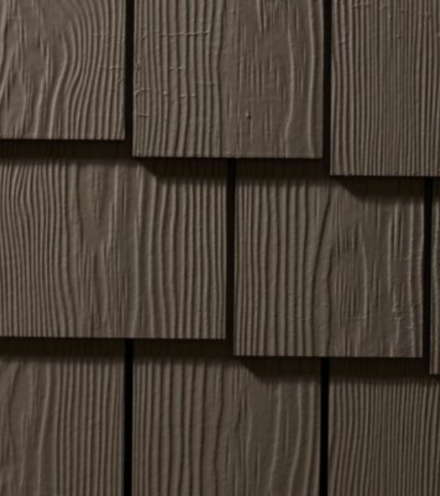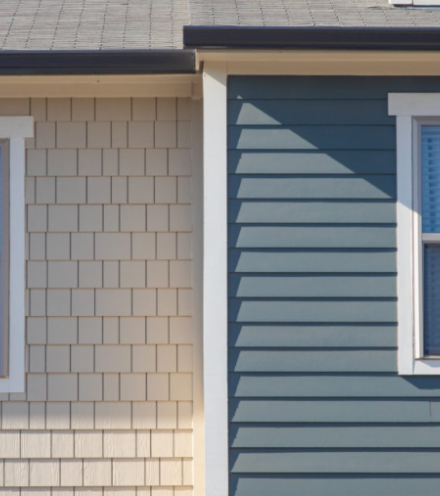Siding has a major impact on your home’s curb appeal. So much so, in fact, that most people put a lot of time and energy into selecting the siding that will ultimately cover their homes. The final choice has to look good, but should also have some other positive attributes, such as durability, that can help make the selection worthwhile. Many people looking for an attractive siding option for their homes will consider cedar wood siding at some point. Wood siding, and cedar in particular, has an appearance that appeals to a lot of people. Whether it’s the versatility, the texture, or simply the classic appearance, if you’ve been considering re-siding your home, you’ve likely considered wood siding.
But all woods, including cedar, need a lot of maintenance to keep that classic appearance. For that reason, you’ve also likely considered wood alternatives to try to find one that will have the look of real cedar siding, but that will be lower in maintenance. Fiber cement siding may be the option you’ve been looking for; with many styles and colors available, combined with better durability, fiber cement makes a better choice for many homes.
Appearance
Most people selecting a siding for their home rank the appearance of the siding high on the list of things they’re looking for. Siding can have a tremendous impact on your home’s resale value simply because of the way that it impacts your home’s appearance.
Cedar is an attractive looking wood siding that has a pleasant wood grain. Wood has been used to side homes for centuries, and there are many different styles of siding that it can be formed into, including Dutch lap, shiplap, and clapboard. Cedar can also be formed into shingles and handhewn shakes to give homes a more rustic appearance as well. The material can be stained to let its natural color and texture show through, or it can be painted in any color that you desire.
Fiber cement siding has a very similar appearance to cedar wood. Like cedar, it comes in planks that can be installed in several patterns including Dutch lap, shiplap, and board and batten. It’s also available in several different shingle styles and individual shakes as well.
Fiber cement can be primed and painted in any color just like cedar, or it can be purchased pre-colored in a wide range of solid colors or wood stains. From the curb or up close, fiber cement and cedar have a very similar appearance. Fiber cement, however, also comes in a few different styles and sizes that are difficult to produce with cedar, such as decorative shingles and architectural panels. This gives you more versatility in terms of how you’ll side your home; you can create more contemporary looks by combining panels and planks with fiber cement, while cedar can only give you more traditional looks.
Maintenance and Durability
There are a lot of different species of wood available for siding a home. One of the reasons that cedar is frequently chosen is because it’s one of the more durable types, requiring less maintenance than fir or other wood species. It doesn’t swell and shrink like other woods and is more resistant to rot than some other woods That doesn’t mean that cedar siding is maintenance free, or the most durable siding option available, however.
Cedar does resist insects and most types of rot, but that resistance is not foolproof. The material can eventually take on water and soften as it ages, particularly if it’s left unstained or treated. It’s recommended that cedar be power washed every few years, as things like dirt and mildew can harm the wood.
In addition, you need to be aware that things such as impacts from hailstones can damage the surface of the cedar, which could result in the siding needing to be sanded down and refinished, or individual shakes or boards being replaced. Cedar also requires a special chemical flame retardant application to help decrease the risk of fire that comes with a wooden house.
While some people choose not to stain their cedar homes, leaving it unpainted or unstained can cause the boards to weather faster and need replacement sooner. If you decide to paint your cedar, keep in mind that you will need to repaint or stain every few years. As the paint ages, it will crack and peel, leaving the cedar below exposed to the elements. This adds to the upkeep and cost of having cedar, and can detract from its appearance over time.
Fiber cement siding needs considerably less maintenance. This heavier material resists moisture absorption, swelling, and rotting, regardless of climate. It’s also insect resistant, and naturally flame retardant with no additional chemicals required. The color used on the surface of fiber cement also resists cracking, peeling, and fading, so it lasts longer than paint on cedar with less maintenance required to help it keep its good looks.
Cost
The final factor that a lot of homeowners need to consider when purchasing new siding for their homes is the cost. Wood siding (like cedar) typically runs around $3 to $6 a square foot, and may cost more when you add in the amount of priming, staining, or painting that is required before the cedar can even be installed.
Fiber cement siding usually costs between $1.85 and $2.65 a square foot – a significant savings over the cost of the cedar. Keep in mind that fiber cement comes already painted or stained as well; it’s ready to install and you won’t need to budget in the cost of having your home painted after installation is done.
When considering costs, you’ll also need to keep in mind that fiber cement requires less upkeep than cedar. So, while cedar may require pressure washing yearly and painting every few years, fiber cement can go longer without needing as much care, so your upfront costs and your ongoing costs will be lower than with cedar.
Make the Right Choice for Your Home
While cedar siding is a beautiful and traditional siding for many homes, the cost, durability, and maintenance can all be major drawbacks for many homeowners. Fiber cement siding can give you the same beautiful look as cedar planks or shakes, but at a lower cost and with a lot less maintenance. When making the choice for your home, be sure to consider the attributes of fiber cement siding. You’re likely to find that it’s the right siding for the job.




